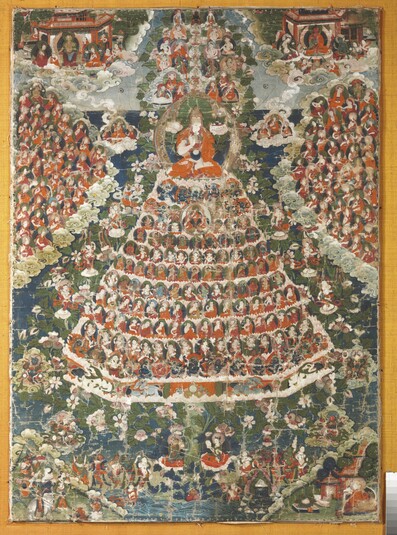
Item: Refuge Field (Buddhist) - Gelug Lineage
| Origin Location | Tibet |
|---|---|
| Date Range | 1800 - 1899 |
| Lineages | Gelug and Buddhist |
| Material | Ground Mineral Pigment on Cotton |
| Collection | Private |
Classification: Object/Concept
Stages of the Path - Field for the Accumulation of Merit (Refuge Field) according to the system of the Gelug tradition of Tibetan Buddhism. In the West the phrase 'Refuge Field' has come to dominate in popular usage the terminology used with reference to Field of Accumulation paintings. This phrase 'Refuge Field' is still much better than to refer to all Field of Accumulation paintings as 'refuge tree' paintings which was also a popular English language name for any such paintings regardless if they incorporated a tree, lotus, palace or billowing white clouds.
In the Gelug Tradition of Tibetan Buddhism there are numerous Refuge Field composition types distinguished both by central figure and also by support (i.e. lotus or tree): (1) Shakyamuni Buddha, (2) Je Tsongkapa, (3) Pabongka Design, and (4) Lotus Support, and (5) Block Print. The first three types are depicted at the peak of a wish-fulfilling tree, seated on a throne and lotus. The fourth type is placed only on a lotus blossom. The two general types of central figures for all types of Refuge Fields are Shakyamuni Buddha and Je Tsongkapa. The variation of the two subject figures depend on the intention, purpose and function of the painting. The former is a Lama Chopa (Shakyamuni) Refuge Field and the latter a Lamrim (Stages of the Path) Lineage (Tsongkapa) Refuge Field. The various Gelug Refuge Fields are a 17th century development based on the 15th and 16th century compositions of Tsongkapa and the Yogachara and Madhyamaka lineages arranged in a hierarchical composition.
Jeff Watt 7-2013
Subject: Refuge Field, Gelug (Main Page)
Collection: Christie's, July New Additions

